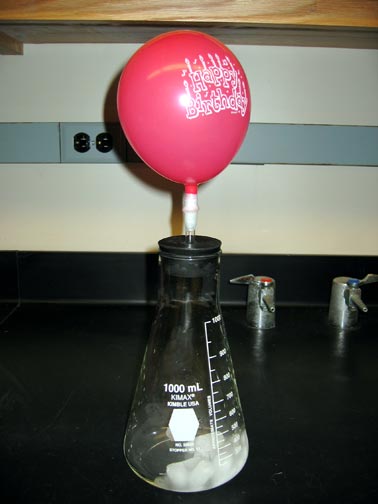The conversion of heat to useful work
 A simple apparatus is used to demonstrate the ability to transform energy, from heat to useful work.
A simple apparatus is used to demonstrate the ability to transform energy, from heat to useful work.
Ingredients: erlenmeyer flask, dry ice, balloon
Procedure: A complete recipe follows.
1. Add dry ice to flask.
2. Fix balloon to flask with a good seal.
3. Observe the inflation of the balloon.
Understanding: James Joule demonstrated the equivalence of transforming the thermodynamic energy of a system by doing work on the system or adding heat to the system. In his classic experiment, the stirring of a liquid (doing work ON the liquid) led to an increase in the temperature of the liquid (normally accomplished by adding heat TO the liquid). Doing work on the liquid and adding heat to the liquid are equivalent means of changing the energy of the system.
Suppose that one observes the system before the energy has been changed and after the energy has been changed, but not during the process. Joule showed that it is possible to know that the energy of the system changed. However, it will not be possible to know how the change in energy was accomplished, by adding heat to the system or by doing work on the system. That wisdom is summarized in the first law of thermodynamics
ΔE = q + w
where the change in energy of the system, ΔE, is equal to the heat added to the system, q, plus the work done on the system, w. For a particular process, q and w will depend on the path followed, but ΔE will depend only on the initial and final states of the system. For that reason, we call the energy, E, a state function.With our simple apparatus, we are able to use the energy of the room to heat the dry ice leading to the sublimation of the solid carbon dioxide
CO2(s) → CO2(g)
The quantity of heat required to transform one mole of solid carbon dioxide to one mole of gaseous carbon dioxide is known as the heat of sublimation and is equal to 6.03 kJ/mol. The sublimation will occur at one atmosphere of pressure and a temperature of 194.67K.The heat absorbed from the surrounding air and flask leads to the sublimation of the dry ice, an increase in the volume of gas, and the inflation of the balloon.
How much work is done in blowing up a balloon?
Question: Using the apparatus described above, a balloon is inflated to a final volume of 1.5 liters. The surrounding air is at a temperature of 20 C and a pressure of 750 torr.Estimate how much work was done to inflate the balloon. Prove that the work done to inflate the balloon is equal to the difference between the change in enthalpy and the change in energy for the process of sublimation.
You can check your answers here.